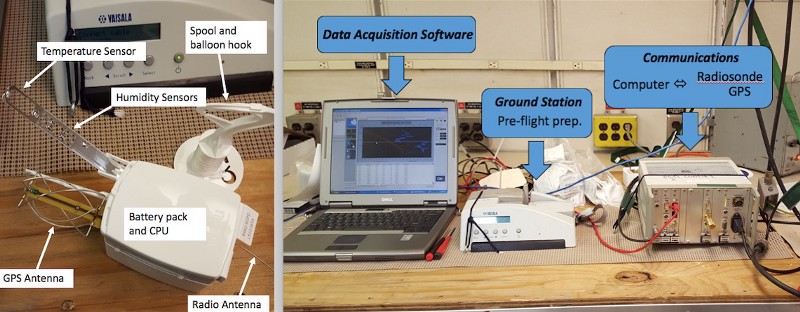Launch ahoy!February 25, 2016by Chris Cox (CIRES)
 Chris with a balloon in the deck staging area — the location where we fill the balloons. Also pictured ENS Marisa Gedney a Ronald H. Brown officer. (Credit: Dan Wolfe, CIRES)
Chris with a balloon in the deck staging area — the location where we fill the balloons. Also pictured ENS Marisa Gedney a Ronald H. Brown officer. (Credit: Dan Wolfe, CIRES)
Launch ahoy!
February 25, 2016by Chris Cox (CIRES)
PACIFIC OCEAN — We have been at sea now for ten days. Our current position is 2°N, 140°W at one of the buoy stations heading towards the equator. Sailing out to the buoy array from Honolulu took several days. During that leg of the trip we were launching radiosondes every four hours (6 per day). The sun was shining for most of the ride, but the winds were strong and the ocean was rough. Dan, the veteran sailor of the balloon crew, had no trouble with the motion of the ship while Matt and I felt a bit queasy. For all of us though, the weather made for adventurous balloon deployments. In the video, Dan is launching from the starboard side of the ship’s fantail. The balloon put up a fight, but Dan made it work and then the balloon went for quite a ride too!
 Matt watches his balloon disappear into the clouds (Credit: Dan Wolfe, CIRES)
Matt watches his balloon disappear into the clouds (Credit: Dan Wolfe, CIRES)
Over the past couple days, the sea state and winds have calmed, helping operations to run smoother. This is good because we are now deploying radiosondes every three hours (8 per day). Eight may not sound like a lot. However, it takes about 1.5 hours for the radiosonde to reach its maximum altitude (~ 80K feet) where the pressure gets low enough that the balloon pops from expansion. We then continue to record the data during its descent (~20 min). We also need a half hour before launch for “preflight” and some time after to close the flight and upload the data. This nearly fills our 3-hour window, so at 8 per day, we are running a round-the-clock operation from the ship. Normally, a single person can launch a radiosonde, but the logistics of work from the ship and considerations for safety mean we are working in a rotating team of two (one of our crew of three is off at all times, probably sleeping).
 A radiosonde (left) and the radiosonde ground station in the lab that we use to communicate with the radiosonde and record the data (right). Credit: Chris Cox, CIRES
A radiosonde (left) and the radiosonde ground station in the lab that we use to communicate with the radiosonde and record the data (right). Credit: Chris Cox, CIRES
Pre-flight begins with unpackaging a new radiosonde and plugging it into the ground station where we use the software program to prepare for the sounding. The procedure includes recording surface meteorological observations and other notes, conducting communications checks with the radiosonde, and performing quality control checks of the radiosonde sensors. Then we set the radiosonde outside to equilibrate to ambient conditions and fill a balloon with helium. We then connect the radiosonde tether to the balloon and release the balloon. Releasing the balloon on the ship can be challenging (as the video suggests); there is infrastructure and equipment on the ship, as well as other operations that we could interfere with (or that could damage the radiosonde). We communicate with the crew about deck operations, and with the bridge about lighting at night and any changes in course that we require in order to orient the vessel favorably given wind conditions.
I almost forgot, Dan wanted me to mention that besides the normal unique conditions you find on a ship, we often have to troubleshoot other issues such as equipment failures. As meteorologists we had to learn quickly the inner workings of our equipment. Patience and good detective skills are a good thing as you never know what you are going to find when you come on watch!!
